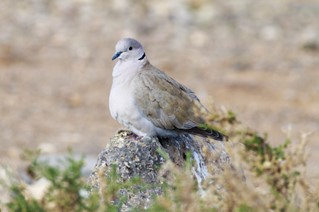CHAPTERS
Navigate to chapter
► Chapter 1 – Introducing the Dove
► Chapter 2 – Are Doves the Right Birds for You?
► Chapter 3 – Dove Behavior
► Chapter 4 – Welcoming A Dove Into Your Home
► Chapter 5 – Your Dove’s Health
► Chapter 6 – Breeding Doves
Chapter 1 – Introducing the Dove

As pets, doves are valued not only for their mellow, peaceful nature, but also for their longevity. With proper care, it’s possible for a dove to live as long as 20 years.
The birds thrive when kept in pairs and are both social and smart. Although quiet, they have loving personalities and tend to bond closely with their humans.
The dove is one of mankind’s most ubiquitous symbols, regarded around the world as a harbinger of peace, safety, and serenity. They are often seen as messengers and are associated with:
- motherhood
- love and grace
- promises made
- devotion
- divinity and holiness
- sacrifice
- ascension
- purification
- hope
Geographically, doves are found on every continent except Antarctica and in every region except the most arid parts of the Sahara Desert.
Metaphorically, doves inhabit the pages of the world’s great religious texts and are often seen as a holy symbol. It was a dove, for instance, that signaled Noah that the waters of the Great Flood had begun to recede. The Christian Holy Spirit is often depicted as a descending dove.
Both doves and pigeons are members of the Columbidae family, which includes 310 species. Of these, the largest member is the Crowned Pigeon, a native of New Guinea, that weighs 4.4-8.8 lbs. / 2-4 kg.
The smallest member is the Ground Dove, which is roughly the size of a common house sparrow and weighs a scant 22 grams.
In terms of general physical characteristics, members of the Columbidae family have:
- short bills
- short legs
- small heads (which they bob to improve their vision)
- large, compact bodies
- large wings capable of strong flight and maneuverability
In many parts of the world, the terms “dove” and “pigeon” are used interchangeably, and scientifically there really is no difference in the two birds.
Typically, the word “pigeon” refers to the larger Columbidae species, while doves are smaller birds.
Overall, doves are docile creatures. They are easy to keep as companion birds, and in fact the care instructions for both doves and pigeons are essentially identical. Both types of Columbidae have enjoyed a close relationship with mankind since ancient times.
Although there are more than 300 species of Columbidae, only five types of doves are routinely sought by enthusiasts to live as pets. Within these five species, however, especially in the world of show doves, there is great diversity.
In the broadest terms, doves fall into two major groups, fruit eaters (mainly kept in zoos and by serious hobbyists) and seed eaters.
Seed eaters are said to be granivorous, while the fruit eaters are frugivorus. The first group tends to feed on seed found on the ground, while the fruit eaters feed in trees.
In addition, many ground doves also consume insects, snails, and worms, and some fruit doves will even eat small reptiles.
The hardy Ring Neck Dove, Streptopelia capicola, domesticated from a species indigenous to Africa, comes in more than 40 color mutations. These are the primary doves shown in competitive exhibits.
(Note that you will see also see these birds referred to as Ringed-Neck Doves.)
All Ring Neck doves have a partial collar of feathers at the nape of the neck. On the wild birds this collar is black, but shades vary within cultivated color mutations.
Since they depend on surface water for hydration, feral Ring Neck doves gather in large flocks near bodies of water to drink and to bathe. Their primary social relationship, however, is with a bonded mate.
The wild Ring Neck dove is dark on the upper side in tones of gray and brown with lavender at the nape of the neck turning pinking below and blending into a white lower belly. Individual plumage varies greatly. Overall these birds measure 9.8-10.4 inches / 25-26.5 cm in length.
There are six types of Ring Neck dove from which all color mutations have been developed:
- Streptopelia capicolacapicola found in southwestern South Africa
- Streptopelia capicolaabunda found in central South Africa
- Streptopelia capicoladamarensis found in the arid interior of southern Africa
- Streptopelia capicolaonguati indigenous to western Nambia and Angola
- Streptopelia capicolatropica native to the tropical and sub-tropical woodlands from South Africa to the South Sudan
- Streptopelia capicolasomalica living from northern Tanzania to Somalia and Ethiopia
Ring Neck doves are often confused with the Barbary dove, Eurasian collared dove, Vinaceous dove, Red-eyed dove, Red turtledove, and Mourning collared dove.
The Ring Neck doves kept as companions are primarily the descendants of other captive birds and are the product of planned breeding programs.
With no exceptional housing requirements beyond adequate space, and known for the ease with which they are bred, Ring Neck doves are also highly popular as companion birds.
Ring Neck doves are often found in pet shops, and are distinguished from other species by their prominent neck ring. Their lifespan in captivity is approximately 20 years.
The Diamond Dove, Geopelia cuneata, is native to Australia. A small and popular creature, the Diamond Dove can be found in approximately a dozen color varieties and is also widely used as a show animal in competition.
They are smaller birds, measuring no more than 9-11 inches / 19-21 cm in length. The wild form has white spots or diamonds on the wings, which are edged in black. Their eyes are orange and encircled by a red eye ring.
Wild Diamond Doves are light blue-grey on the head, neck, and breast, with a creamy abdomen and brown-gray coloration on the back and tail. The legs and feet are pink and the bill is dark grey.
They are seen most often on the ground in pairs or small feeding groups, taking seeds from grass and eating ants. Diamond Doves have a variety of calls that are slow, soft, mournful and may rise to a pleasing falsetto tone.
Larger inhabitants of an aviary can bully Diamond Doves, but otherwise the species is an easy bird to breed and to keep. They do spend a large amount of time on the ground and should not be kept in cages with wire bottoms, which can seriously injure their feet.
Diamond Doves require smaller seed mixes like those prepared for finch and canary species and should also be given vegetables and greens.
Since the birds swallow seeds whole, they need to be supplied with grit to aid with digestion. Like all doves, they also have a high need for companionship and will do best when kept in pairs.
Their lifespan is even longer than that of the Ring Neck dove. Diamond Doves can live to the ripe old age of 25 in captivity!
The Mourning Dove, Zenaida macroura, has a sad, almost melancholy call or “coo.” It is native to North and South America, and is a placid and peaceful creature.
You may also see this dove referred to as a Wood Dove, Turtledove, American Mourning Dove, Rain Dove, Carolina Pigeon, or Carolina Turtledove.
Their bodies are a muted light grey and brown. On average Mourning Doves are 12 inches / 31 cm in length and weigh 4.0-6 ounces / 112-170 grams. They are slender with a short, dark bill and short, reddish legs. In flight, their wings are broad and elliptical and their tails are long and tapered.
Continue Reading…
Want to read the entire thing?

